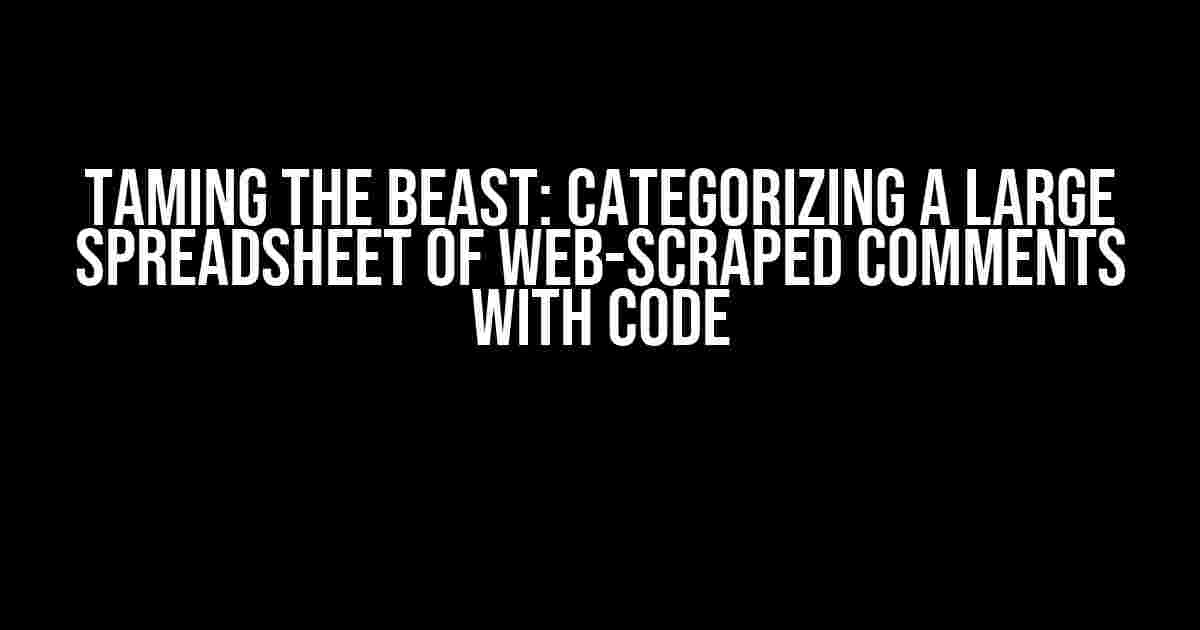- The Problem: A Sea of Unorganized Data
- The Solution: A Step-by-Step Guide to Taming the Beast
- Step 1: Preprocessing – Cleaning and Normalizing the Data
- Step 2: Tokenization – Breaking Down Comments into Individual Words
- Step 3: Removing Stop Words and Stemming
- Step 4: Feature Extraction – Converting Tokens into Numerical Features
- Step 5: Categorization – Unsupervised Learning with K-Means Clustering
- Step 6: Visualization and Exploration
- Conclusion: Taming the Beast
- Bonus Section: Tips and Tricks
The Problem: A Sea of Unorganized Data
You’ve spent hours, maybe even days, scraping comments from various websites, and now you’re left with a massive spreadsheet that looks like a digital dump yard. Thousands of rows, each containing a comment, with no rhyme or reason to it. It’s overwhelming, to say the least. You’re not alone; many web scrapers have been in your shoes, wondering, “Is there a way to categorize a large spreadsheet full of web-scraped comments using code?”
The Solution: A Step-by-Step Guide to Taming the Beast
Fear not, dear web scraper, for we have a solution that will turn your chaotic spreadsheet into a well-organized, easily analyzable dataset. In this article, we’ll walk you through a step-by-step process to categorize your web-scraped comments using code.
Step 1: Preprocessing – Cleaning and Normalizing the Data
Before we dive into categorization, we need to ensure our data is squeaky clean. This means removing any unnecessary characters, converting all text to lowercase, and handling missing values.
import pandas as pd
# Load the spreadsheet into a pandas dataframe
df = pd.read_csv('comments.csv')
# Remove HTML tags and punctuation
df['comment'] = df['comment'].apply(lambda x: re.sub(r'<.*?>', '', x))
df['comment'] = df['comment'].apply(lambda x: re.sub(r'[^\w\s]', '', x))
# Convert all text to lowercase
df['comment'] = df['comment'].apply(lambda x: x.lower())
# Handle missing values
df['comment'].fillna('', inplace=True)
Step 2: Tokenization – Breaking Down Comments into Individual Words
Tokenization is the process of breaking down text into individual words or tokens. This allows us to analyze each word separately and identify patterns.
import nltk from nltk.tokenize import word_tokenize # Tokenize each comment df['tokens'] = df['comment'].apply(word_tokenize)
Step 3: Removing Stop Words and Stemming
Stop words, like “the,” “and,” and “a,” don’t add much value to our analysis. We’ll remove them to reduce noise and improve categorization.
from nltk.corpus import stopwords
from nltk.stem import WordNetLemmatizer
# Define English stop words
stop_words = set(stopwords.words('english'))
# Remove stop words and stem tokens
lemmatizer = WordNetLemmatizer()
df['tokens'] = df['tokens'].apply(lambda x: [lemmatizer.lemmatize(y) for y in x if y not in stop_words])
Step 4: Feature Extraction – Converting Tokens into Numerical Features
We’ll use the bag-of-words model to convert our tokenized comments into numerical features. This will allow us to feed our data into a machine learning algorithm.
from sklearn.feature_extraction.text import TfidfVectorizer # Create a TF-IDF vectorizer vectorizer = TfidfVectorizer() # Fit the vectorizer to our data and transform tokens into features X = vectorizer.fit_transform(df['tokens'])
Step 5: Categorization – Unsupervised Learning with K-Means Clustering
Now that we have our features, we can use unsupervised learning to categorize our comments. We’ll employ K-Means clustering to group similar comments together.
from sklearn.cluster import KMeans # Define the number of clusters (categories) n_clusters = 5 # Create a K-Means model and fit it to our data kmeans = KMeans(n_clusters=n_clusters) kmeans.fit(X) # Get the cluster labels for each comment labels = kmeans.labels_ # Add the cluster labels to our original dataframe df['category'] = labels
Step 6: Visualization and Exploration
It’s time to visualize our categorized data and explore the results. We’ll use a bar chart to display the distribution of categories.
import matplotlib.pyplot as plt
# Plot the category distribution
plt.xlabel('Category')
plt.ylabel('Frequency')
plt.title('Comment Category Distribution')
plt.hist(df['category'], bins=n_clusters)
plt.show()
Conclusion: Taming the Beast
With these steps, you’ve successfully categorized your large spreadsheet of web-scraped comments using code. You’ve tamed the beast, and now you can analyze and gain insights from your data. Remember to adjust the preprocessing, tokenization, and feature extraction steps based on your specific needs and data characteristics.
Bonus Section: Tips and Tricks
Handling Outliers and Noisy Data
To improve the accuracy of your categorization, consider removing outliers and noisy data. You can use techniques like PCA or t-SNE to reduce dimensionality and detect anomalies.
Using Supervised Learning for Categorization
If you have labeled data, consider using supervised learning algorithms like Naive Bayes, SVM, or Random Forest. These methods can provide more accurate categorization results.
Integrating with Other Tools and Technologies
Once you’ve categorized your comments, you can integrate your results with other tools and technologies. For example, you can use natural language processing to perform sentiment analysis or topic modeling.
| Tool/Technology | Description |
|---|---|
| Natural Language Processing | Perform sentiment analysis, topic modeling, or aspect-based analysis |
| Data Visualization | Use libraries like Matplotlib, Seaborn, or Plotly to create interactive visualizations |
| Machine Learning | Use supervised or unsupervised learning algorithms for further analysis and categorization |
By following these steps and tips, you’ll be well on your way to taming the beast of web-scraped comments and unlocking valuable insights from your data.
Frequently Asked Question
Ever wondered how to tame the chaos of a large spreadsheet filled with webscraped comments? We’ve got you covered!
Can I categorize a large spreadsheet of webscraped comments manually?
The good old manual way! While it’s possible to categorize comments manually, it’s a daunting task, especially when dealing with a large dataset. You’ll need to dedicate a significant amount of time and effort to sift through each comment, identify patterns, and assign categories. Not to mention the possibility of human error and bias creeping in. So, unless you have a whole lot of free time and patience, we’d recommend exploring more efficient methods.
Can I use Natural Language Processing (NLP) to categorize webscraped comments?
NLP to the rescue! Yes, you can leverage NLP techniques, such as text classification, sentiment analysis, and topic modeling, to categorize webscraped comments. These algorithms can help identify patterns, sentiments, and topics within the comments, making it easier to assign relevant categories. You can use popular NLP libraries like NLTK, spaCy, or Stanford CoreNLP to get started. Just keep in mind that you’ll need to preprocess your data, train your models, and fine-tune your approach to achieve optimal results.
How can I use clustering algorithms to categorize webscraped comments?
Clustering to the rescue! Clustering algorithms, such as k-means, hierarchical clustering, or density-based clustering, can help group similar comments together based on their content, sentiment, or other features. This unsupervised learning approach can identify hidden patterns and structures within your data, allowing you to categorize comments into meaningful groups. You can use libraries like scikit-learn or scipy to implement clustering algorithms and visualize your results.
Can I use deep learning models to categorize webscraped comments?
Deep learning to the rescue! Yes, you can utilize deep learning models, such as convolutional neural networks (CNNs) or recurrent neural networks (RNNs), to categorize webscraped comments. These models can learn complex patterns and representations from your data, allowing for more accurate categorization. However, be prepared to invest time and computational resources into training and fine-tuning your models. Popular deep learning libraries like TensorFlow, PyTorch, or Keras can help you get started.
What are some popular tools and libraries for categorizing webscraped comments?
Tool time! Some popular tools and libraries for categorizing webscraped comments include scikit-learn, spaCy, NLTK, Stanford CoreNLP, TensorFlow, PyTorch, Keras, and OpenCV. You can also explore cloud-based services like Google Cloud Natural Language API, Microsoft Azure Cognitive Services, or IBM Watson Natural Language Understanding. These tools and libraries can help you preprocess, analyze, and categorize your webscraped comments with ease.




